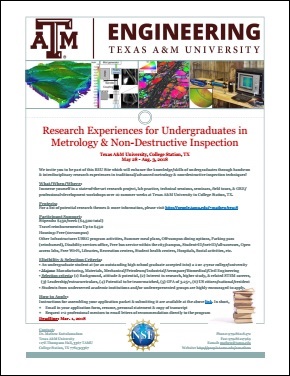
Images from the Summer-2018 REU Site - Welcome Meeting!
The summer-2018 cohort of NSF-REU students & their faculty mentors at Texas A&M University.
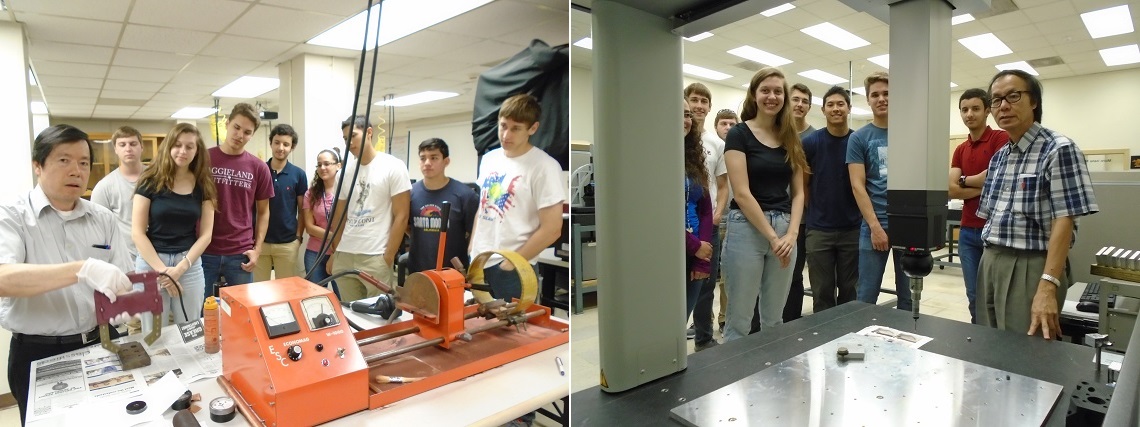
Images from the Summer-2018 REU Site - Workshops!
The summer-2018 cohort at the NDI workshop (instructed by Dr. Fang), & at the Metrology workshop (instructed by Dr. Hung).
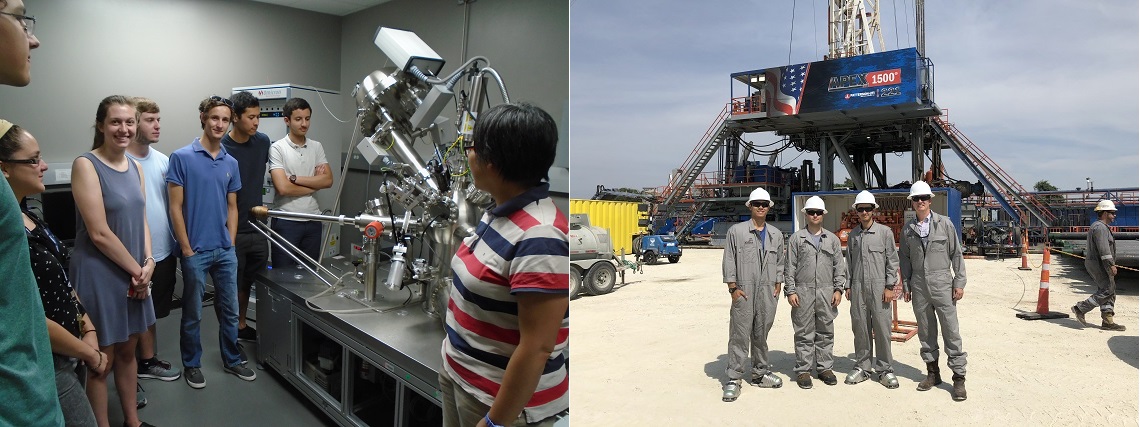
Images from the Summer-2018 REU Site - Tours!
The summer-2018 cohort at the Materials Characterization Facility tour, & at the Patterson drilling rig.
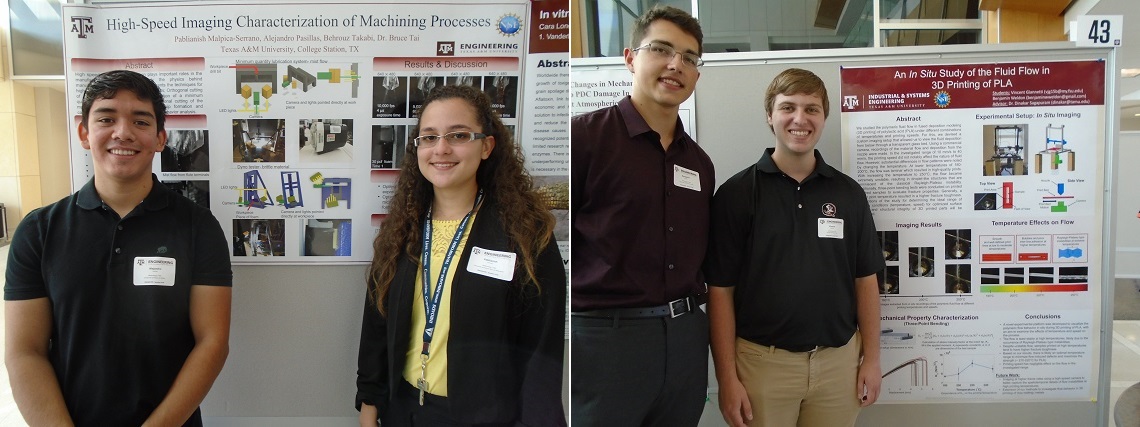
Images from the Summer-2018 REU Site - Research Symposium!
Alejandro/Pablianish & Benjamin/Vincent present their posters at the Engineering USRG & REU Research Poster Symposium at Texas A&M University.
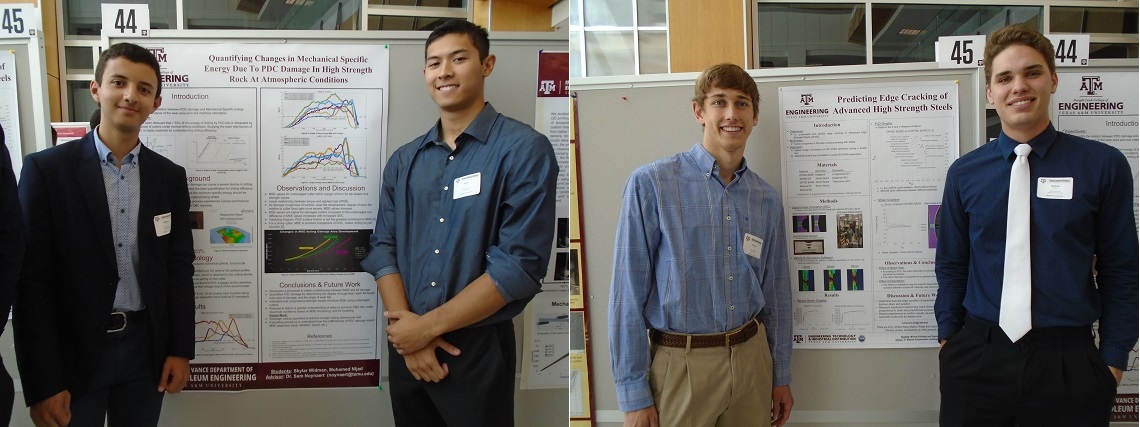
Images from the Summer-2018 REU Site - Research Symposium!
Skylar/Mohamed & Michael/Stephen present their posters at the Engineering USRG & REU Research Poster Symposium at Texas A&M University.
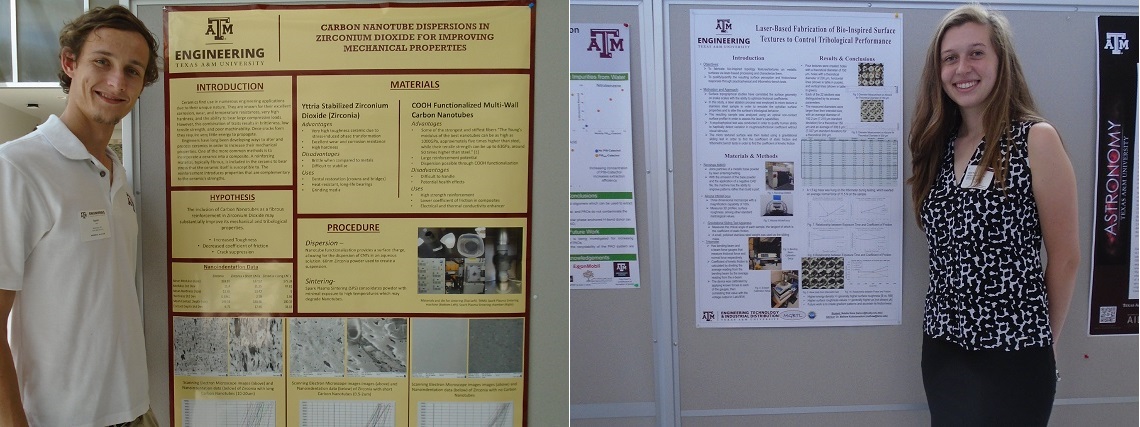
Images from the Summer-2018 REU Site - Research Symposium!
Daniel & Natalie present their posters at the Engineering USRG & REU Research Poster Symposium at Texas A&M University.
[This is a retired webpage of the summer-2018 REU site]
Please click on the OPPORTUNITIES tab above to check for a current offering.
 Research Experiences for Undergraduates (REU) Site
Research Experiences for Undergraduates (REU) Site
[Summer-2018]
Interdisciplinary Research Experiences in Metrology & Non-Destructive Inspection
Texas A&M University, College Station, TX
May 28 - Aug. 3, 2018

This REU site will enhance the knowledge and skill-level of a cohort of undergraduates through empowering, hands-on and interdisciplinary research experiences in metrology and non-destructive inspection (NDI). Metrology, the science of measurement, and (nondestructive) inspection, transcends scales, materials, and disciplines; yet, rarely are its salient aspects emphasized. This site is a first-of-its-kind direct response to specific concerns raised by regional industry partners and technical workforce recruiters. The impact of this site will be to create empowered future researchers and a workforce well-rooted in metrology/NDI, and motivate them to pursue advanced study and STEM careers.
What/When/Where:
You will be hosted at TAMU over 10 summer weeks, where you will immerse in a hands-on research experience comprising of a state-of-the-art research project, technical
sessions/seminars, lab practice, field tours, and GRE/professional-development workshops. You will be part of a vertically-integrated team, each comprising of 2 REU students, 1 senior undergraduate and 1
graduate student (from TAMU) and a faculty mentor working in concert on a specific research project. Your deliverables will include a public dissemination of research results (short report and poster), and a follow-up plan tailored to your career interests. This on-site experience will be supplemented
with follow-ups for continued interaction, growth, and guidance for pursuing advanced
study.
Program Goals:
This REU site program will place emphasis on the major aspects of scientific measurement and inspection, especially in relevance to the energy and manufacturing sectors. Intended goals are:
1. To excite, empower and educate 30+ undergraduates in traditional/advanced metrology and NDI,
2. For you to experience an immersive research-training through a related transformative project,
3. To mold you as an independent/collaborative researcher capable of effective communication,
4. For you to learn to ask the right questions, formulate plans, pragmatically interpret data, and
5. To inspire and enable you to pursue advanced study and related STEM careers.
Participant Support:
- Stipends: $450/week ($4,500 total)
- Travel Reimbursements: Up to $450
- Housing: On-campus student dormitories will be reserved for you, and paid for
-
TAMU infrastructure for summer REU students (partial list):
> Undergraduate Summer Research Grants (USRG) program activities that include GRE and professional-development workshops
> Free on-campus accommodation
> Parking pass (reimbursed)
> Summer meal plans, and off-campus dining options
> Disability services office
> Free bus service within the campus/city
> Student ID, net ID, and all related accesses
> Open Access Labs
> Libraries
> Recreation centers
> Student health center, and hospitals
> Other social activities, etc.
Eligibility:
- A current undergraduate student at a 2 or 4-year college/university
(or an outstanding high school graduate, accepted into such an institution, and slated to start his/her degree in the Fall)
- Pursuing a degree (or having demonstrated a background and interest) in one or more of the following fields:
> Manufacturing
> Materials Science & Engineering
> Mechanical Engineering
> Petroleum Engineering
> Industrial Engineering (Processes)
> Aerospace Engineering
> Biomedical Engineering
> Civil Engineering
- GPA of 3.25 or higher
- US citizen, national, or permanent resident
[Please refer to the "Projects" section below for a list of potential research themes]
[Please refer to the "How to Apply" section below for application instructions/deadlines]
Projects
This REU site will enhance the knowledge and skill-level of undergraduates in metrology/NDI. Under this umbrella topic, the 6 major intellectual themes include:
1.
Forensic metrology of sub-surface/surface behavior in bio-inspired FGM
2. Fabricating/qualifying bio-inspired surfaces to
enhance mechanical performance
3.
Non-destructive measurement/tolerancing of inaccessible geometries
4.
High-speed microscopy/characterization of the dynamics of fluid flow
5.
Ultra high-frequency bandwidth measurement of forces
6.
High-resolution in-situ scanning/monitoring of wellbore casing integrity
[Theme-1: Forensic Metrology of Sub-Surface/Surface Behavior in Bio-Inspired FGM]
Additive Manufacturing of Bio-Inspired Functionally-Graded Materials for Tailoring Mechanical/Tribological Responses
[Dr. Mathew Kuttolamadom]
Objective - To design, fabricate and evaluate mammalian-tooth-inspired functionally-graded materials to be able to predict and control sub-surface/surface mechanical and tribological responses to thermo-mechanical input stimuli. This project will enable the design and manufacture of tougher bulk sub-structures coupled with wear-resistant surfaces.
Description - This project will first involve the formulation of mechanical property gradient designs inspired by mammalian-tooth structures. Then, powder-bed selective laser melting (SLM) and powder-fed laser engineered net shaping (LENS) additive manufacturing (AM) will be utilized to respectively impart density and compositional gradients, to create spatial gradients in hardness/moduli. Finally, micro-mechanical testing, digital image correlation, and tribometry will be used to evaluate their performance, while forensic metrology of their behavior will be conducted through microscopy, spectroscopy and interferometry.
Fig. 1: Laser melting of SS316L powder bed & Sections printed at different AM process parameters (left); Hardness variations at different scan speeds & energy densities (right)
Fig. 2: SEM image & Nano-indendations on pig tooth (left); LENS MR-7 AM machine & Powder mixer (middle); Compositional gradients across a SS316L-Ni sample (right)
[Theme-2: Fabricating/Qualifying Bio-Inspired Surfaces to Enhance Mechanical Performance]
Manufacturing & Characterizing Bio-Inspired Surface Topological Gradients to Reduce Friction/Wear
[Dr. Mathew Kuttolamadom]
Objective - To fabricate and characterize snake-scale-inspired surface topology features and their gradients on select metallic/non-metallic materials to improve their tribological performance, i.e., to lower friction and wear. This project will enable deterministic topology feature rules for reducing friction/wear, and hence help create durable and resilient surfaces.
Description - First, the core topological principles that enable the low frictional coefficient and wear in scaled reptilian skin will be investigated. Then, a selective laser melting (SLM) additive manufacturing (AM) machine will be used to fabricate the desired topological feature gradients; the effects of energy-density-based AM process parameters on the resolution/achievability of features and textures will be investigated as well. Finally, their tribological performance (friction and wear) will be quantified using a tribometer, and high-resolution microscopy/spectroscopy will be conducted to elucidate their behavior.
Fig. 1: 3D image and profile measurements taken from a freeze-dried snake scale specimen (left); 3D topological map of specimen (right) & profilometer (inset)
Fig. 2: Micro-scale features being created by the laser (left) & the SLM AM machine, process parameters & test pattern (inset); 3D image & height profile of a round pillar (right)
[Theme-3: Non-Destructive Measurement/Tolerancing of Inaccessible Geometries]
Ultrasound Inspection & Mapping of Gun-Drilled Holes
[Dr. Jyhwen Wang]
Objective - To investigate the effectiveness of NDI sequences and sampling in measuring the dimensions of high-aspect ratio gun-drilled holes in opaque large-size parts. This knowledge will enable standardized NDI testing sequences based on feature type, as well as real-time process monitoring/control while drilling these holes for better part quality.
Description - A semi-automated inspection methodology for gun-drilling will be developed in this project. The advances rely on the design of an innovative fixture and the development of data processing algorithms. One or multiple ultrasound probes will be mounted on and moved along a guide to investigate the use of real-time data to monitor/control the gun-drilling process, as well as to inspect the drilled holes. Collected data will be processed via computational geometry algorithms in real-time and post-process.
Fig. 1: Concept of using an ultrasound probe to non-destructively inspect drilled holes
Fig. 2: A high-performance gun drill from Sandvik Coromant
[Theme-4: High-Speed Microscopy/Characterization of the Dynamics of Fluid Flow]
Visualization of Mist Flow in Energy-Saving Minimum Quantity Lubrication (MQL) Machining
[Dr. Bruce Tai]
Objective - To fabricate a test bed and develop a measurement method for mist flow visualization. The setup will be used to investigate the mist flow transformation as a function of drill geometry and to observe the oil droplet trajectory near the tool cutting edges using high-speed high-resolution microscopy. This knowledge will enable better through-channel design, parameter control for productivity, and an inspection method for MQL tools.
Description - A production MQL setup will be used to generate mist flow through a transparent drill bit. The channel designs will be made by stereolithography 3D-printing of clear photopolymers. Students will design/fabricate the system and optimize the high speed high-res camera to capture flow images under various spindle speeds, passage geometries, and flow settings; the images will be processed using particle image velocimetry (PIV).
Fig. 1: (a) 3D-printed drills with through-channels, (b) Test bed design for microscopy
[Theme-5: Ultra High-Frequency Bandwidth Measurement of Forces]
Measurement of Shear Band Force Oscillations in High-speed Machining of Ti/Ni-Based Superalloys
[Dr. Dinakar Sagapuram]
Objective - To capture cutting force oscillations arising from the shear band flow instabilities in machining of Ti and Ni-based superalloys. The shear banding frequency in high-speed machining (>1 m/s) of these alloys is typically in the 5-40 kHz which is beyond the capability of typical force sensors. To this end, we will explore the use of indirect force sensing techniques based on accelerometry and non-contact high-speed imaging methods.
Description - First, acceleration measurements at low cutting speeds where shear band frequency is ≤1 kHz will be measured using a MEMS-based accelerometer, mounted close to the tool tip. This data will be combined with force data from a piezoelectric dynamometer to determine the effective dynamic mass of the system to estimate high-frequency forces The second method will involve in situ high-speed imaging, where a high-speed CMOS video camera (>50 kHz framerate at ~1 µm spatial resolution) will be used to measure the tool displacement and acceleration at high spatio-temporal resolution. Besides complementing the accelerometer based shear band force measurements, high-speed imaging will also shed light on the shear band dynamics itself.
Fig. 1: (a) Optical micrograph showing the ‘saw-tooth’ shear banding chip morphology of Ti-6Al-4V, (b) Electron backscatter diffraction map showing the highly sheared morphology within the (black) band
Fig. 2: Shear banding in cutting of Ti-6Al-4V: high-speed image sequence (40,000 fps) revealing two-phase shear band flow
[Theme-6: High-Resolution In-Situ Scanning/Monitoring of Wellbore Casing Integrity]
High-resolution In-situ Investigation of Wellbore Casings
[Dr. Sam Noynaert]
Objective - To use laser scanning technology in surface/downhole tests to identify damaged wellbore casings, measure the extent of the damage, and identify the potential source. This will lead to an improved understanding of casing damage mechanisms as well as the development of an improved technique for identifying wellbore casing damage and thus potential integrity issues. This project will include cooperation from a major US steel casing manufacturer in providing manufacturing data and industry-leading expertise which will help both data interpretation and student perspectives.
Description - This project involves the design/fabrication of a surface testing apparatus as well as completing the surface testing of the NDI equipment for oilfield tubulars. The first task is to test/confirm the inspection technology prior to deployment to a downhole environment. The test apparatus will consist of stand on which 5’ - 15’ casing sections can be safely rested. The stand will be able to handle casing sizes ranging from 53-lb/ft, 9-5/8” OD casing to 17-lb/ft, 4-½” casing. Once on the horizontal stand, the casing will be filled with a drilling fluid such as mud, fresh water or some other combination to test their effects on downhole data acquisition. Once secured in the stand, laser scanning will then be utilized to measure and log view data.
Fig. 1: Test apparatus/DAQ to be used for enhanced in-situ casing inspection, (inset) High-resolution laser scan output example (LaserStream, L.P.)
Fig. 2: Scaled/instrumented drill rig drilling control/automation research (2 meter tall derrick that can drill 1.5" holes in 2.5' thick rock)
How to Apply
The application packet consists of two parts as detailed below. Please follow these instructions when submitting your application:
1. Email mathew@tamu.edu (note the single "t" in "mathew") the following documents, merged as a single pdf file in the given order:
(i) Completed/signed application form [Download docx] [Download pdf] [Download pdf (fillable)]
(ii) Up-to-date resume/CV [limit of 2 pages]
(iii) Personal statement, that addresses the following 4 questions [limit of 1 page]:
(a) Describe your major technical accomplishments/experiences to date
(b) Why are you a good fit for this REU program
(c) Describe what you plan to achieve through this REU program
(d) Your long-term career goals, and plans for advanced study (if any)
(iv) Current transcript [unofficial copy]
2.
Request letters of recommendation from 1-2 of your professional mentors [minimum 1; maximum 2], and ask them to email the program directly at mathew@tamu.edu. Additional guidelines:
- The letter should contain your (full) name, current educational institution, and relationship of recommender to applicant
-
The letter should address your academic and/or research abilities, experiences and potential
(You might want to provide your recommender the REU program details, your up-to-date resume, and the above instructions)
(Please confirm with your recommender that they have indeed emailed their recommendation letter by the due date)
Deadline:
March 5, 2018 [All application documents should be received by this date]
Selection Criteria:
(1) Technical background, attitude, and research aptitude/potential
(2) Interest in research, higher study, and related STEM careers
(3) Relevant leadership and extracurricular activities
(4) Potential to be matched in a vertically-integrated team
Students from underserved academic institutions and/or underrepresented groups are strongly encouraged to apply
Selection Procedure:
All complete applications received by the deadline
will be evaluated and ranked by a faculty panel. Following this, select students might be contacted via email for specific queries and/or for a short phone/Skype interview. Final decisions and notifications are expected to be sent out by mid March.
Contact:
Dr. Mathew Kuttolamadom
Assistant Professor, Manufacturing & Mechanical Engineering Technology
Dept. of Engineering Technology & Industrial Distribution
Dept. of Materials Science & Engineering
Texas A&M University
117E Thompson Hall, 3367 TAMU, College Station, TX 77843-3367
Phone: 979-862-8472;
Fax: 979-862-7969
E-mail: mathew@tamu.edu
Website: http://people.tamu.edu/~mathew/








